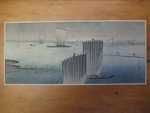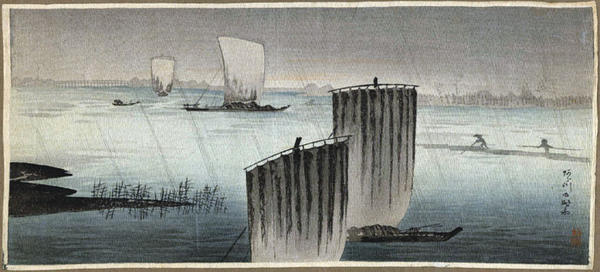| | |
| Artist: | Shotei Takahashi (1871-1945) Hiroaki — 松亭高橋、弘明 |
| Title: | Early Winter Rain at Arakawa — 荒川の時雨 |
| Series: | |
| Date of first edition?: | 1909 (in the decade of) |
| Publisher (first edition)?: | Watanabe Shozaburo — 渡辺 |
| Publisher (this edition)?: | Watanabe Shozaburo — 渡辺 |
| Medium (first edition): | Woodblock |
| Medium (this edition): | Woodblock |
| Format (first edition): | Mitsugiri
|
| Format (this edition): | Mitsugiri |
| DB artwork code: | 46792 |
| Notes (first edition)?: |
M-109. Late fall / early winter rain at Arakawa
Medium: Original Japanese Woodblock Print
Edition: First
Date: 1909-1916
Publisher: S. Watanabe
Reference: No Folk #75
Notes: Pre-earthquake design. |
|
| Notes (this edition)?: |
| The following information was taken from the original web listing of this artwork. Note that there may be some inaccuracies:
Artist: Takahashi Shotei
Title: Shower in Early Winter Rain at Arakawa River
Medium: Original Creped Japanese Woodblock Print
Edition: First
Date: 1909-1916
Publisher: S. Watanabe
Reference: No Folk #75
Size: 5 -1/2 x 12 -1/4 " - Crepe Paper
Condition: Very fine.
Notes: Pre-earthquake design. A seldom seen state, with fresh colors and still tipped to original paper sheet.
Chirimen-gami-e ("crepe paper") were crinkled paper prints, sometimes referred to as 'crepon'. Ukiyo-e crepe prints were produced at least as early as 1800 in Edo, and throughout the nineteenth century they were used on occasion for alternate states of some ukiyo-e designs. The compression technique resulted in a highly textured surface and slightly smaller paper size. |
|
| Artist Bio: |
Takahashi Shotei was born in Tokyo with the given name of Takahashi Katsutaro. At a young age he was trained in Nihon-ga , the traditional Japanese painting style by his uncle Matsumoto Fuko, and beginning around 1907 Shotei started designing for the Watanabe Color Print Company. Shotei was among the first designers to be recruited into Watanabe's stable of artists, which would later expand to include Goyo, Shinsui, Hasui, Kasamatsu, Koson and Koitsu among others. Many Watanabe prints were designed for export, primarily to North America, where the demand for all things Japanese was high in the early 20th century.
By 1923 Shotei had produced nearly 500 designs for Watanabe, when Tokyo was hit by the Great Kanto earthquake -- the worst recorded natural catastrophe in the history of Japan. The fires ignited by the earthquake raged for three days, and Watanabe's print shop and all the woodblocks created by Shotei and the other early shin hanga artists, were destroyed.
After the earthquake Shotei created another 250 prints mostly depicting scenic Japanese landscapes in the shin hanga style he had helped to define. He continued to work for Watanabe, but also worked with the publishers Fusui Gabo and Shobido Tanaka, where he had more control over the finished print than was possible with Watanabe.
Shotei used a variety of names, signatures and seals during his lifetime. From 1907 until 1922 he used the name Shotei, and after 1922 Hiroaki and Komei.
|
|






